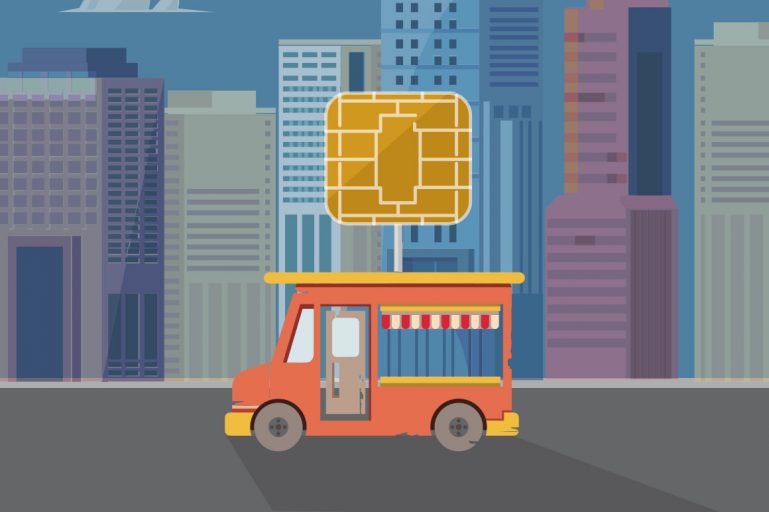
Will Your Food Truck be EMV Compliant by October 1st?
Technology is always ever-adapting and improving, and with that improvement always comes changes in how we live, interact, work, and otherwise get through our daily life.
It’s a part of culture that always needs to be paid attention to by the business owner, for sooner or later there will always be something that needs to be addressed and adapted to so as to thus flow into the new trend, if not even take extra advantage of it, with seamless transition.
And for many Food Truck owners, that is starting to happen again now with something known as ‘EMV’ cards and technology. A recent movement with how people pay electronically, the EMV system has in fact been implicated to a high degree throughout the rest of the world. In fact, as Richard Willis of M&R Trailers, a Florida-based food truck manufacturer informed us, “The U.S. is the last major market where people primarily use magnetic-stripe cards.”
But we’re jumping on the bandwagon, whether we really want to or not. For on October 1st, 2015 (so far just a suggestion, but could turn real soon, and any retailer who does not meet it is liable for counterfeit fraud losses), the EMV liability shift will take place, affecting all operating US food truck owners who accept credit cards. So it’s about time that we make sure we’re informed on this new venture and dive head-first into some of the most important questions that YOU need answered in order to be ready by Autumn.
Named after the three companies that first started using and promoting EMV (EuroPay, Mastercard, and Visa), this is basically a complete replacement in the standard credit card design. Basically put, instead of the classic magnetic strip, all of the payment details and other electronic dealies are stored in a single small card chip. This allows it to be simply held up and beeped next to a reader for quick and easy sales. But what’s REALLY important here isn’t the ‘smaller, more advanced’ aspect to it, but the fact that every single time the chip is read, it presents a different and purely unique identifier, which keys very significantly to the next question.
Why the Change?
For as much as we’d like to think otherwise, or imagine it hasn’t affected most of us in any real way, Identity and Credit Card Fraud is an increasingly large problem, is very much within the public eye.
“Fraud is continuing to grow exponentially and will always be an unfortunate reality in business… Also, the U.S. makes about 24% of all credit card sales and is responsible for nearly 50% of fraud worldwide.” – Richard Willis, owner of M&R Specialty Trailers and Trucks
But with the EMV chip, not only do most, if not all, the gadgets many of these card-thieves use to steal card information just by standing near one become absolutely useless, but those that DO get their hands on a card data can only use it once at the most. Both these figures combined have proven to significantly reduce many of these theft cases, providing an even more secure life to everyone.
All that aside, if there’s any reason for your food truck, or any business to implement these EMV systems, it’s simply this: your customers will need it. We may be the last market, but the use of this technology IS growing, and as we’ve seen with other monetary changes in history there shall be a day, sooner or later, where most potential customers will reach for one of these chipped cards as their primary payment source. Having an updated system keeps fast and easy transactions, happy people, and eliminates the risk of losing a large chunk of future visits due to the ‘hassle’ (it’s petty I know, but that’s how things often are in food sales, especially for those on a time crunch).
What Do YOU Need to Do?
For those already in business, this simply requires Upgrading your POS system, getting a new reading attachment, etc. Though for some of these, and of course for those just starting up their new food truck business, it will be easier to just buy the whole new POS outfitted with this technology.
How Much Will This Cost?
New Payment Terminals for bigger retailers and companies usually cost between $500-$1000 each; but that’s big business, smaller terminals for simple shops often average $200-$500, and can even go as low as $110 in our market. Rather cheap, considering how much everything ELSE cost. Who knows, they could even develop a phone attachment just like with the swipers.
What Should I Expect in a Day’s Shift?
Overall it’s the same old same old, as for the transaction itself, it all depends on whether one gets a ‘card dipping’ reading system or contactless/near field communication. The latter is just as fast and easy as a swipe, just hold up and tap next to the reader, while the other requires inserting the card into a slot; sort of like paying for gas or parking spaces. What’s notable about dipping is the person has to make sure to hold it there for a few seconds to read properly; as such, this will technically take a little longer for each customer, but since these transactions are usually filled with you doing other little things as the transaction is going along, the final time from order-to-complete should likely be the exact same. And yes, there will be a verification step, like signing or entering a pin, for every purchase, just like credit cards.
Want to try ShopKeep for yourself?
Just answer a few easy questions.
Need help finding the right point of sale?
Just complete the form. We’ll call you right back to explain how ShopKeep can work for you.
Hit the ground running.Sprinting, in fact!
Read our free, comprehensive guide, Small Business 101, to learn all you need to know about starting a thriving business.

